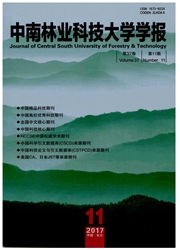

 中文摘要:
中文摘要:
为了探讨太行山低山丘陵区不同水土保持林地土壤渗透性能及其影响因素,本文通过野外调查和室内分析相结合的方法,分析了该区域3种30年生的侧柏、刺槐和栓皮栎水土保持林地土壤的入渗特征并进行综合评价,同时进行入渗过程模拟及土壤入渗影响因素研究,结果表明:(1)3种水土保持林地土壤初渗速率、平均入渗速率、稳渗速率、前30min入渗量均大于相同土层裸地土壤入渗数值,同时也表现为随土壤深度的增加而降低,不同样地0-20 cm土层土壤渗透速率均呈现侧柏〉刺槐〉栓皮栎〉裸地的趋势。(2)不同样地土壤渗透性能综合评价结果为侧柏(2.414)〉刺槐(-0.817)〉栓皮栎(-1.169)〉裸地(-1.180)。(3)土壤入渗模型拟合结果表明Philip入渗模型对不同恢复阶段土壤入渗过程拟合效果最好,Kostiakov入渗模型拟合效果次之,Horton入渗模型拟合效果最差,不适合用于描述该区域土壤入渗特征。(4)土壤渗透特性指标与土壤密度、非毛管孔隙度、总孔隙度、有机质质量分数、根质量密度、根表面积密度、根体积密度、根平均直径存在显著相关关系(P〈0.05);土壤理化性质指标和根系结构指标中对土壤渗透性能产生影响作用最大的分别是总孔隙度和根表面积密度,典型相关负荷量分别为21.029和0.713。
 英文摘要:
英文摘要:
To analyze characteristics and influencing factors of soil infiltration of different soil and water conservation forest lands in hilly region of Taihang Mountains, three typical 30-year-old soil and water conservation forests (Platycladus orientalis, Robiniap seudoacacia and Quercus variabilis) in this area were selected to study the soil infiltration characteristics and influencing factors, simulate the soil infiltration process and evaluate the soil permeability through field sampling and laboratory analysis. The results showed that: (1) Soil initial infiltration rate,average infiltration rate, stable infiltration rate and accumulated infiltration capacity of different soil and water conservation forest lands were higher than that in bare land in same soil layer,and decresed with increasing depth. The soil infiltration rate in 0-20 cm layer was in the order of Platycladus orientalis 〉 Robiniap seudoacacia 〉 Quercus variabilis〉 bare land. (2) Soil permeability values of different soil and water conservation forest lands were presented as Platycladus orientalis(2.414)〉 Robiniap seudoacacia(-0.817) 〉 Quercus variabilis(-1.169) 〉 bare land(-1.180). (3) Simulated infiltration processes with Kostiakov and Philip models showed that the two fit better with the infiltration than Horton model. (4) There was a notable relationship (P 〈 0.05) between soil permeability index and soil bulk density, non-capillary porosity, total porosity, soil organic matter content, root weight density root surface area density, root volume density, root average diameter. For the soil infiltration capacity, the most important indicators of soil physical and chemical characteristics and root structure were total porosity and root surface area density, and the canonical correlation coefficient of which were 21.029, 0.713 respectively.
 同期刊论文项目
同期刊论文项目
 同项目期刊论文
同项目期刊论文
 期刊信息
期刊信息
